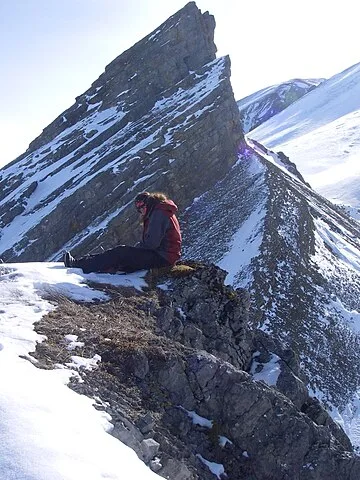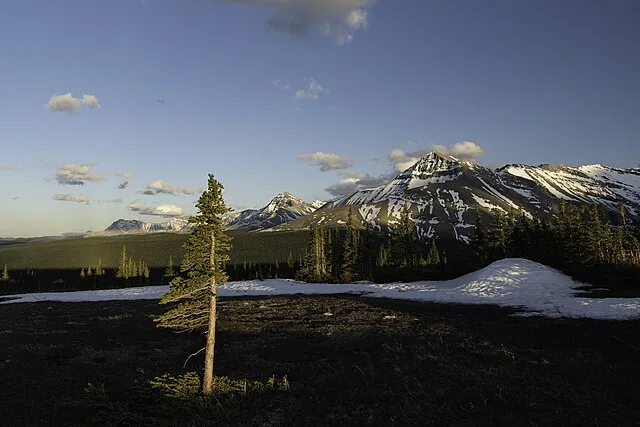The highest mountain in the Northwest Territories does not have a formal name as recognize by the Government of Canada or the Territory. Since early 2005, James Coleridge, the Summits of Canada Expedition Leader has been working with the Nahanni Butte and Deh Cho First Nations to identify a name that reflects both the people and the heritage of the area.
Mackenzie Mountains.Un-named Peak:2,773 metres , 9,098 feet
| Attribute | Details |
|---|---|
| Altitude | 2,773 m, 9,098 f |
| Location | 61° 52′ N 127° 42′ W / 61°52′ 29″ -127°40′ 49″ |
| NTS Map | 95/E 13 Mount Sidney Dobson |
| Calendar | July 15 – September 1 |
| Parks | Nahanni National Park Reserve |
| Fast Facts | CAPITAL: Yellowknife, NWT PROVINCIAL FLOWER: Mountain Avens BIRD: Gyrfalcon PROVINCIAL TREE: Tamarack |
History

Author: Mcoupe – wikimedia.org
A yet unnamed peak in the Mackenzie Mountains, measured at 9,098 ft, (2,773 metres) is located in the Ragged Range of the Logan Mountains, a sub range of the Mackenzie Mountains.
The Mackenzie Mountains are a northern extension of the Rocky Mountains and lies along the southwestern border of the Northwest Territories, and form the headwaters of the South Nahanni River. The range runs northwest between the British Columbia border and the Peel River valley. The range is about 800 km long. It forms the southern border between Yukon and Northwest Territories.
The wide sweeping valleys of the Mackenzie and Liard rivers cut through this region. Rivers slice through the extensive high plateau and mountains, carving deep canyons. Those of the South Nahanni River are best known, but similar breathtaking canyons are found along other rivers in this region. Dense boreal forests of white and black spruce, with stands of jack-pine or lodgepole pine, cover the rolling uplands and terraces above the Mackenzie and Liard river valleys. Named for Sir Alexander Mackenzie, who explored the Mackenzie River in 1789.
Who came up with the name
In William Buckingham, a mountain climber, coined it Nirvana in 1965 and is referred to as “Mount Nirvana” in alpine literature. The mountain is in the Ragged Range, southwest of the South Nahanni River. For a long time, Mount Sir James MacBrien (2,764 m) 30 km to the north of Mount Nirvana was designated as the highest peak in the Northwest Territories, but Nirvana is at least 9m higher. A native of Port Perry, Ontario, MacBrien (1878-1938) was a distinguished soldier and commissioner of the RCMP from 1931 to 1938.
First expedition
The first climbing expedition into the area was led by John Milton in 1960. John Milton and Ed Arnold landed at Hole-in-the-Wall Lake, where they were doing ecological research. They decided to head west through the various passes. John Milton climbed Mount Savage, and from there he saw Nirvana, which he referred to as Mount Nahanni.
In 1965 Bill Buckingham and Lew Surdam landed at Hole-in-the-Wall Lake and approached the mountain from the south, but decided it was too steep, so they went around to the west and then north of the mountain. From here they climbed the peak via the northwest ridge.
The best known peaks in the Logan Mountains are a series of granite spires known as the “Cirque of the Unclimbables”. However, Nirvana is in a second group of mountains, known as the Ragged Range, about 30 km south of the Cirque of the Unclimbables. Mount Nirvana is the highest peak in the Northwest Territories.

Author : Fresh.waffles – wikimedia.org
Safety and Preparedness
Prior to embarking on your expedition to Mount Nirvana, it’s crucial to comprehend and prepare for the potential risks and challenges inherent in climbing this remote and rugged peak. Here are some indispensable tips to ensure your safety and enhance your enjoyment of the adventure:
Acknowledge the Risks
Mount Nirvana presents a multitude of challenges for climbers, including:
- Variable Weather: Weather conditions in the mountains can shift unexpectedly, with sudden storms, gusty winds, and frigid temperatures posing significant hazards.
- Difficult Terrain: The rough and isolated terrain of Mount Nirvana demands physical exertion, with steep inclines, loose rocks, and precarious footing necessitating cautious navigation.
- Remote Location: Situated in a secluded wilderness area, Mount Nirvana is far from medical facilities and other forms of assistance. In the event of an emergency, rescue operations may be arduous and time-consuming.
Be Prepared
To mitigate risks and ensure your safety while scaling Mount Nirvana, it’s essential to:
- Appropriate Gear: Equip yourself with high-quality gear suitable for mountain climbing, including sturdy boots, insulated clothing, waterproof outerwear, a reliable backpack, and essential safety equipment like a helmet, harness, and ropes.
- Emergency Communication: Carry a satellite phone, emergency locator beacon (ELB), or personal locator beacon (PLB) to signal for help in case of emergencies.
- Navigation Tools: Bring along a map, compass, or GPS device to navigate the intricate terrain of the mountain and avoid getting lost. Familiarize yourself with the route beforehand and remain flexible in adjusting your plans based on prevailing conditions.
- First Aid Kit: Pack a comprehensive first aid kit containing essential supplies for treating common injuries such as cuts, bruises, sprains, and altitude sickness. Include medications for pain relief, allergic reactions, and other medical conditions.
- Hydration and Nutrition: Stay hydrated and nourished during your climb by carrying an ample supply of water and high-energy snacks such as trail mix, energy bars, and dried fruit. Plan your meals and ration your food to ensure you have sufficient sustenance for the duration of your expedition.
Wilderness Survival Skills
In addition to possessing the right gear and equipment, it’s imperative to acquire basic wilderness survival skills to cope with unforeseen circumstances while ascending Mount Nirvana:
- Shelter Construction: Learn how to construct emergency shelters using natural materials like branches, leaves, and rocks to shield yourself from the elements.
- Fire Starting: Master the art of starting fires using a waterproof lighter, matches, or friction-based methods to stay warm and cook food if necessary.
- Signaling Techniques: Practice various signaling techniques such as using a whistle, mirror, or brightly colored clothing to attract attention and communicate with potential rescuers.
- Survival Mindset: Cultivate a positive mindset and resilience to cope with stress, fear, and uncertainty in challenging situations. Remain composed, assess your options rationally, and make informed decisions based on the available resources.
Conclusion
Mount Nirvana, the highest peak in the Northwest Territories, lacks a formal name recognized by the Government of Canada or the Territory. The mountain, often referred to as ‘Mount Nirvana’ in alpine literature, presents significant challenges for climbers, including variable weather conditions, difficult terrain, and its remote location. Prior to climbing Mount Nirvana, it’s essential to acknowledge these risks and adequately prepare by equipping oneself with appropriate gear, including sturdy boots, insulated clothing, and essential safety equipment. Additionally, climbers should carry emergency communication devices, such as satellite phones or locator beacons, and possess navigation tools like maps or GPS devices to navigate the mountain’s intricate terrain. Acquiring basic wilderness survival skills, such as shelter construction, fire starting, signaling techniques, and maintaining a positive survival mindset, is crucial for coping with unforeseen circumstances while ascending Mount Nirvana.
FAQs
Why doesn’t Mount Nirvana have a formal name recognized by the government?
Mount Nirvana lacks a formal name recognized by the Government of Canada or the Territory of the Northwest Territories. It is often referred to as ‘Mount Nirvana’ in alpine literature.
What kind of gear is essential for climbing Mount Nirvana?
Climbers should equip themselves with appropriate gear, including sturdy boots, insulated clothing, essential safety equipment such as helmets and harnesses, as well as emergency communication devices like satellite phones or locator beacons.
Why is it important to possess wilderness survival skills when climbing Mount Nirvana?
Possessing wilderness survival skills, such as shelter construction, fire starting, signaling techniques, and maintaining a positive survival mindset, is crucial for coping with unforeseen circumstances and emergencies while ascending Mount Nirvana.